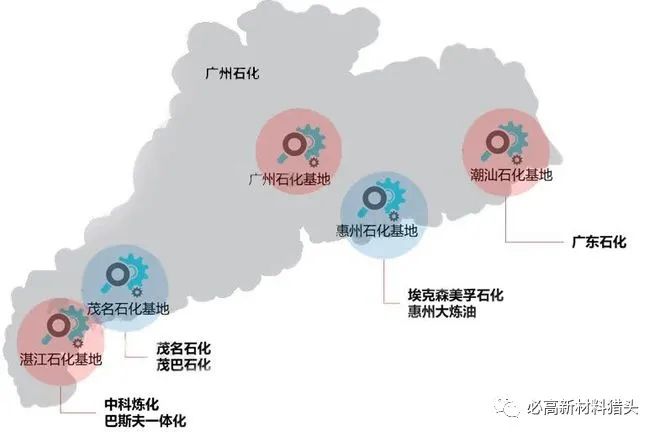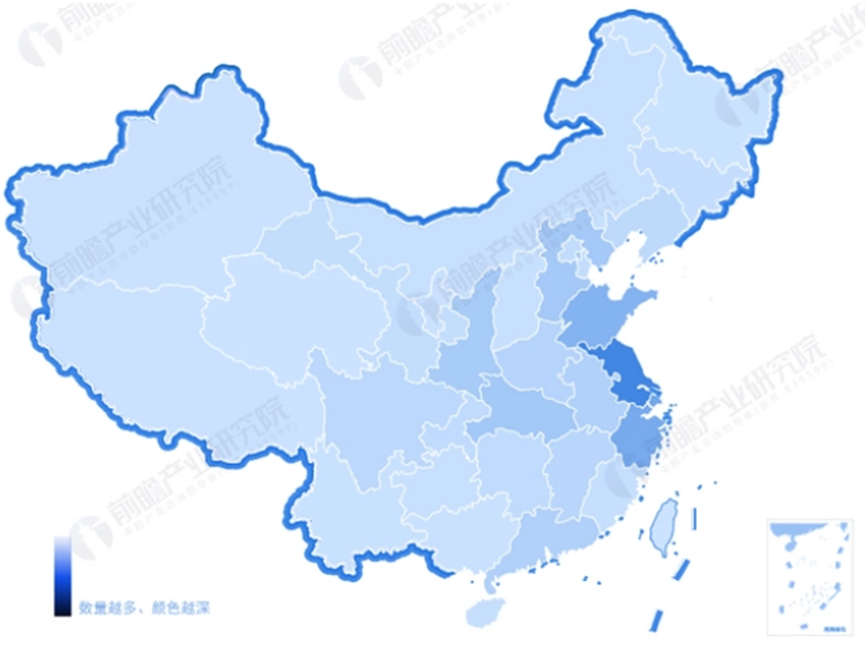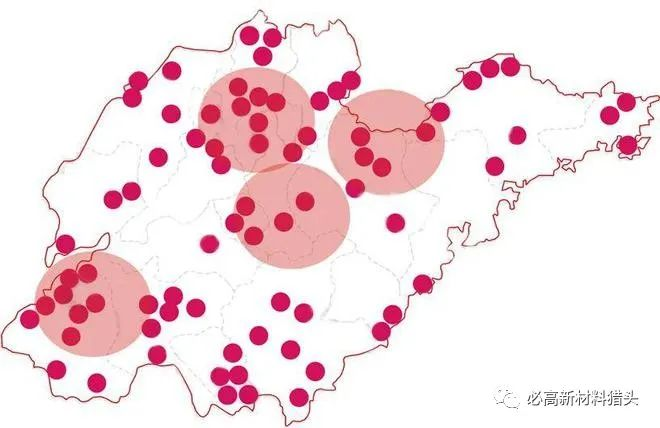Indasteri ea lik'hemik'hale ea Chaena e ntse e tsoela pele ho tloha boemong bo boholo ho ea ho tsela e nepahetseng, 'me likhoebo tsa lik'hemik'hale li ntse li fetoha, tse tla tlisa lihlahisoa tse hloekisitsoeng haholoanyane. Ho hlaha ha lihlahisoa tsena ho tla ba le phello e itseng ponaletsong ea tlhahisoleseding ea mebaraka le ho khothaletsa potoloho e ncha ea ntlafatso ea indasteri le ho kopanya.
Sengoliloeng sena se tla shebana le liindasteri tse ling tsa bohlokoa indastering ea lik'hemik'hale ea China le libaka tsa tsona tse tsepamisitsoeng haholo ho senola phello ea nalane ea bona le matlotlo a lisebelisoa indastering. Re tla hlahloba hore na ke libaka life tse nang le boemo bo hlahelletseng liindastering tsena le ho sekaseka hore na libaka tsena li ama ntlafatso ea liindasteri tsena joang.
1. Moreki e moholo ka ho fetisisa oa lihlahisoa tsa lik'hemik'hale Chaena: Profinseng ea Guangdong
Profinse ea Guangdong ke sebaka se nang le tšebeliso e kholo ka ho fetisisa ea lihlahisoa tsa lik'hemik'hale Chaena, haholo-holo ka lebaka la tekanyo e kholo ea GDP. Kakaretso ea GDP ea Profinse ea Guangdong e fihlile ho li-yuan tse libilione tse 12.91, e behiloe pele Chaena, e khothalelitseng nts'etsopele e atlehileng ea pheletso ea bareki ba ketane ea indasteri ea lik'hemik'hale. Ka mokhoa oa thepa ea lihlahisoa tsa lik'hemik'hale Chaena, hoo e ka bang 80% ea tsona e na le mokhoa oa tsamaiso ho tloha leboea ho ea ka boroa, 'me 'maraka o le mong oa bohlokoa oa ho qetela ke Profinseng ea Guangdong.
Hajoale, Profinse ea Guangdong e shebane le nts'etsopele ea metheo e mehlano e meholo ea petrochemical, eo kaofela e nang le limela tse kholo tse kopaneng tsa tlhoekiso le lik'hemik'hale. Sena se nolofalelitse nts'etsopele ea ketane ea indasteri ea lik'hemik'hale Profinseng ea Guangdong, ka hona ho ntlafatsa sekhahla sa ntlafatso le tekanyo ea phepelo ea lihlahisoa. Leha ho le joalo, ho ntse ho e-na le lekhalo la phepelo ea 'maraka, e lokelang ho tlatsetsoa ke metse e ka leboea e kang Jiangsu le Zhejiang, ha lihlahisoa tse ncha tsa thepa e phahameng li hloka ho tlatsetsoa ka lisebelisoa tse tsoang linaheng tse ling.
Setšoantšo sa 1: Metheo e mehlano e meholo ea petrochemical Profinseng ea Guangdong
2. Sebaka se seholohali sa kopano bakeng sa ho hloekisoa Chaena: Profinseng ea Shandong
Porofense ya Shandong ke sebaka se seholo ka ho fetisisa sa ho hlwekisa oli naheng ya China, haholoholo Dongying City, e bokelletseng palo e kgolo ka ho fetisisa ya dikgwebo tsa lehae tse hlwekisang oli. Ho tloha bohareng ba 2023, ho na le likhoebo tse fetang 60 tsa ho hloekisa Profinseng ea Shandong, tse nang le matla a ho sebetsa a lithane tse limilione tse 220 ka selemo. Matla a tlhahiso ea ethylene le propylene a boetse a feta lithane tse limilione tse 3 ka selemo le lithane tse limilione tse 8 ka selemo, ka ho latellana.
Indasteri ea ho hloekisoa ha oli Profinseng ea Shandong e qalile ho ntlafala bofelong ba lilemo tsa bo-1990, 'me Kenli Petrochemical e le setsi sa pele se ikemetseng sa tlhoekiso, sa lateloa ke ho theoa ha Dongming Petrochemical (eo pele e neng e tsejoa e le Dongming County Oil Refining Company). Ho tloha ka 2004, libaka tsa ho hloekisa tse ikemetseng Profinseng ea Shandong li kene nakong ea tsoelo-pele e potlakileng, 'me likhoebo tse ngata tsa ho hloekisa tsa lehae li qalile kaho le ts'ebetso. Tse ling tsa likhoebo tsena li tsoa tšebelisanong ea litoropong le mahaeng le phetohong, ha tse ling li tsoa tlhoekisong le phetohong ea lehae.
Ho tloha ka 2010, likhoebo tse hloekisang oli sebakeng sa Shandong li 'nile tsa ratoa ke likhoebo tsa' muso, 'me likhoebo tse ngata li ntse li rekoa kapa li laoloa ke likhoebo tsa mmuso, ho kenyeletsoa Hongrun Petrochemical, Dongying Refinery, Haihua, Changyi Petrochemical, Shandong Huaxing, Zhenghe Petrochemical, Qingdao Great Chemical Refinery, Refinery ea Bobeli ea Jinan. joalo-joalo Sena se potlakisitse tsoelo-pele e potlakileng ea lihloekisi tsa lehae.
3. Moetsi e moholo oa lihlahisoa tsa meriana Chaena: Profinseng ea Jiangsu
Profinse ea Jiangsu ke mohlahisi e moholo ka ho fetisisa oa lihlahisoa tsa meriana Chaena, 'me indasteri ea eona ea tlhahiso ea meriana ke mohloli oa bohlokoa oa GDP bakeng sa profinse. Profinse ea Jiangsu e na le likhoebo tse ngata tse mahareng tsa indasteri ea meriana, tse etsang kakaretso ea 4067, e leng se etsang hore e be sebaka se seholo ka ho fetisisa se felileng sa tlhahiso ea meriana China. Har'a bona, Toropo ea Xuzhou ke e 'ngoe ea litoropo tse kholo ka ho fetisisa tsa tlhahiso ea meriana Profinseng ea Jiangsu, e nang le likhoebo tse etelletseng pele tsa indasteri ea meriana ea malapeng joalo ka Jiangsu Enhua, Jiangsu Wanbang, Jiangsu Jiuxu, le likhoebo tse ka bang 60 tsa theknoloji e phahameng lefapheng la biopharmaceuticals. Ho feta moo, Toropo ea Xuzhou e thehile mabala a mane a naha a lipatlisiso le nts'etsopele mafapheng a litsebi a kang tumor biotherapy le nts'etsopele ea ts'ebetso ea limela tsa bongaka, hammoho le litsi tse fetang 70 tsa lipatlisiso le nts'etsopele ea liprofinse.
Yangzijiang Pharmaceutical Group, e Taizhou, Jiangsu, ke e 'ngoe ea likhoebo tse kholo ka ho fetisisa tsa tlhahiso ea meriana profinseng esita le ka har'a naha. Lilemong tse 'maloa tse fetileng, e 'nile ea e-ba ka makhetlo-khetlo lethathamong le holimo la 100 la indasteri ea meriana ea Chaena. Lihlahisoa tsa sehlopha li akaretsa likarolo tse ngata tse kang anti-tshwaetso, pelo, tšilo ea lijo, hlahala, tsamaiso ea methapo, 'me bongata ba bona ba na le tlhokomeliso e phahameng le karolo ea' maraka 'marakeng oa malapeng le oa machaba.
Ka kakaretso, indasteri ea tlhahiso ea meriana Profinseng ea Jiangsu e na le boemo ba bohlokoa haholo China. Ha se feela moetsi e moholo ka ho fetisisa oa lihlahisoa tsa meriana Chaena, empa hape ke e 'ngoe ea lik'hamphani tse kholo ka ho fetisisa tsa tlhahiso ea meriana naheng.
Setšoantšo sa 2 Kabo ea lefats'e ea likhoebo tsa tlhahiso ea lipakeng tsa meriana
Mohloli oa lintlha: Prospective Industry Research Institute
4. Mohlahisi e moholo oa Chaena oa lik'hemik'hale tsa elektronike: Profinseng ea Guangdong
E le setsi se seholo ka ho fetisisa sa tlhahiso ea indasteri ea elektronike Chaena, Profinse ea Guangdong e boetse e fetohile setsi se seholo ka ho fetisisa sa tlhahiso ea lik'hemik'hale tsa elektronike le tšebeliso ea lisebelisoa Chaena. Boemo bona bo tsamaisoa haholo ke tlhoko ea bareki Profinseng ea Guangdong. Porofense ea Guangdong e hlahisa makholo a mefuta ea lik'hemik'hale tsa elektroniki, tse nang le lihlahisoa tse pharalletseng ka ho fetesisa le sekhahla se holimo sa ntlafatso, se koahelang masimo a kang lik'hemik'hale tsa elektroniki tse metsi, lisebelisoa tse ncha tsa boemo ba elektroniki, lisebelisoa tsa lifilimi tse tšesaane le lisebelisoa tsa ho roala tsa elektroniki.
Ka ho khetheha, Zhuhai Zhubo Electronic Materials Co., Ltd. ke moetsi oa bohlokoa oa lesela la fiber glass grade grade, low dielectric, le ultrafine glass fiber fiber. Changxin Resin (Guangdong) Co., Ltd. haholo-holo e hlahisa elektronike grade amino resin, PTT, le lihlahisoa tse ling, ha Zhuhai Changxian New Materials Technology Co., Ltd. haholo-holo rekisa elektronike solder flux, ho hloekisa tikoloho, le lihlahisoa Fanlishui. Likhoebo tsena ke likhoebo tse emelang tšebetso ea lik'hemik'hale tsa elektroniki Profinseng ea Guangdong.
5. Sebaka se seholo ka ho fetisisa sa tlhahiso ea fiber ea polyester Chaena: Profinseng ea Zhejiang
Profinse ea Zhejiang ke setsi se seholo ka ho fetisisa sa tlhahiso ea fiber ea polyester naheng ea China, e nang le likhoebo tsa tlhahiso ea polyester chip le sekala sa tlhahiso ea polyester filament e fetang lithane tse limilione tse 30 ka selemo, sekala sa tlhahiso ea polyester staple fiber e fetang lithane tse limilione tse 1.7 / selemo, le likhoebo tse fetang 30 tsa tlhahiso ea polyester chip, tse nang le kakaretso ea tlhahiso ea selemo e fetang lithane tse limilione tse 4.3/3. Ke e 'ngoe ea libaka tse kholo ka ho fetisisa tsa tlhahiso ea lik'hemik'hale tsa polyester tsa China. Ntle le moo, ho na le likhoebo tse ngata tsa masela le tse lohang Profinseng ea Zhejiang.
Likhoebo tse emelang lik'hemik'hale Profinseng ea Zhejiang li kenyelletsa Sehlopha sa Tongkun, Sehlopha sa Hengyi, Sehlopha sa Xinfengming, le Zhejiang Dushan Energy, har'a tse ling. Likhoebo tsena ke likhoebo tse kholo ka ho fetisisa tsa tlhahiso ea lik'hemik'hale tsa polyester Chaena 'me li holile le ho ntlafala ho tloha Zhejiang.
6. Sebaka se seholo ka ho fetisisa sa tlhahiso ea lik'hemik'hale tsa mashala Chaena: Profinseng ea Shaanxi
Profinse ea Shaanxi ke setsi sa bohlokoa sa indasteri ea lik'hemik'hale ea mashala ea China le setsi se seholo sa tlhahiso ea lik'hemik'hale tsa mashala Chaena. Ho latela lipalo-palo tsa data tse tsoang Pingtouge, profinse e na le likhoebo tse fetang 7 tsa mashala ho isa ho olefin, tse nang le tekanyo ea tlhahiso ea lithane tse fetang limilione tse 4.5 ka selemo. Ka nako e ts'oanang, tekanyo ea tlhahiso ea mashala ho ethylene glycol e boetse e fihlile ho lithane tse limilione tse 2,6 / selemo.
Indasteri ea lik'hemik'hale tsa mashala Profinseng ea Shaanxi e tsepamisitse maikutlo ho Yushen Industrial Park, e leng sebaka se seholo ka ho fetisisa sa lik'hemik'hale tsa mashala naheng ea China mme e bokella likhoebo tse ngata tsa tlhahiso ea lik'hemik'hale tsa mashala. Har'a bona, likhoebo tse emelang ke mashala a mahareng a Yulin, Shaanxi Yulin Energy Chemical, Pucheng Clean Energy, Yulin Shenhua, jj.
7. Motheo o moholo ka ho fetisisa oa tlhahiso ea lik'hemik'hale oa letsoai oa Chaena: Xinjiang
Xinjiang ke setsi se seholo ka ho fetisisa sa tlhahiso ea lik'hemik'hale tsa letsoai Chaena, se emetsoeng ke Xinjiang Zhongtai Chemical. Matla a eona a tlhahiso ea PVC ke lithane tse limilione tse 1.72 / selemo, e leng se etsang hore e be khoebo e kholo ka ho fetisisa ea PVC Chaena. Bokhoni ba eona ba tlhahiso ea caustic soda ke lithane tse limilione tse 1.47 ka selemo, hape ke kholo ka ho fetisisa Chaena. Libaka tse nang le letsoai tse netefalitsoeng Xinjiang li ka ba lithane tse limilione tse likete tse 50, tsa bobeli ho Profinseng ea Qinghai. Letsoai la letša la Xinjiang le na le boemo bo phahameng le boleng bo botle, bo loketseng ho sebetsa ka botebo le ho hloekisoa, le ho hlahisa lihlahisoa tsa lik'hemik'hale tsa letsoai tse nang le boleng bo phahameng, tse kang sodium, bromine, magnesium, joalo-joalo, e leng lisebelisoa tse tala tse molemo ka ho fetisisa bakeng sa ho hlahisa lik'hemik'hale tse amanang. Ntle le moo, Lop Nur Salt Lake e Seterekeng sa Ruoqiang ka leboea-bochabela ho Tarim Basin, Xinjiang. Lisebelisoa tsa potash tse netefalitsoeng li ka ba lithane tse limilione tse 300, tse ikarabellang ho feta halofo ea mehloli ea potash ea naha. Likhoebo tse ngata tsa lik'hemik'hale li kene Xinjiang bakeng sa lipatlisiso 'me li khethile ho tsetela mererong ea lik'hemik'hale. Lebaka le ka sehloohong la sena ke molemo o felletseng oa lisebelisoa tse tala tsa Xinjiang, hammoho le ts'ehetso e khahlang ea pholisi e fanoeng ke Xinjiang.
8. Sebaka se seholo ka ho fetisisa sa China sa tlhahiso ea lik'hemik'hale tsa khase ea tlhaho: Chongqing
Chongqing ke setsi se seholo ka ho fetisisa sa tlhahiso ea lik'hemik'hale tsa khase ea tlhaho Chaena. Ka mehloli e mengata ea khase ea tlhaho, e thehile liketane tse ngata tsa indasteri ea lik'hemik'hale tsa khase ea tlhaho mme e bile toropo e etelletseng pele ea lik'hemik'hale tsa khase ea tlhaho Chaena.
Sebaka sa bohlokoa sa tlhahiso ea indasteri ea lik'hemik'hale ea khase ea Chongqing ke Setereke sa Changshou. Sebaka sena se atolositse karolo e tlase ea indasteri ea lik'hemik'hale ea khase ea tlhaho ka monyetla oa lisebelisoa tse tala. Hona joale, setereke sa Changshou se hlahisitse lik'hemik'hale tse sa tšoaneng tsa khase ea tlhaho, tse kang acetylene, methanol, formaldehyde, polyoxymethylene, acetic acid, vinyl acetate, polyvinyl alcohol, PVA optical film, EVOH resin, joalo-joalo nanotubes, lithium battery solvents, joalo-joalo.
Likhoebo tse emetseng nts'etsopele ea indasteri ea lik'hemik'hale tsa khase ea tlhaho Chongqing li kenyelletsa BASF, China Resources Chemical, le China Chemical Hualu. Likhoebo tsena li nka karolo ka mafolofolo nts'etsopele ea indasteri ea lik'hemik'hale ea khase ea tlhaho ea Chongqing, ho khothaletsa boqapi ba theknoloji le ts'ebeliso, le ho matlafatsa tlholisano le botsitso ba indasteri ea lik'hemik'hale ea khase ea Chongqing.
9. Profinse e nang le palo e kholo ka ho fetisisa ea libaka tsa boikhathollo tsa lik'hemik'hale Chaena: Profinseng ea Shandong
Profinse ea Shandong e na le palo e kholo ka ho fetisisa ea libaka tsa boikhathollo tsa indasteri ea lik'hemik'hale Chaena. Ho na le libaka tse fetang 1000 tsa lirapa tsa lik'hemik'hale tsa boemo ba liprofinse le tsa naha naheng ea China, ha palo ea lirapa tsa lik'hemik'hale Profinseng ea Shandong e feta 100. Ho ea ka litlhoko tsa naha bakeng sa ho kena lirapeng tsa liindasteri tsa lik'hemik'hale, sebaka sa serapa sa liindasteri tsa lik'hemik'hale ke sebaka se seholo sa ho bokella lik'hamphani tsa lik'hemik'hale. Libaka tsa liindasteri tsa lik'hemik'hale Profinseng ea Shandong li ajoa haholo-holo metseng e kang Dongying, Zibo, Weifang, Heze, eo ho eona Dongying, Weifang, le Zibo e nang le palo e phahameng ka ho fetisisa ea likhoebo tsa lik'hemik'hale.
Ka kakaretso, nts'etsopele ea indasteri ea lik'hemik'hale Profinseng ea Shandong e batla e tsepame, haholo-holo ka mokhoa oa lirapeng tsa boikhathollo. Har'a tsona, libaka tsa boikhathollo tsa lik'hemik'hale metseng e kang Dongying, Zibo, le Weifang li tsoetse pele haholoanyane 'me ke libaka tse ka sehloohong tsa ho bokelloa ha indasteri ea lik'hemik'hale Profinseng ea Shandong.
Setšoantšo sa 3 Kabo ea Libaka tse ka Sehloohong tsa Indasteri ea Lik'hemik'hale Profinseng ea Shandong
10. Sebaka se seholo ka ho fetisisa sa tlhahiso ea lik'hemik'hale tsa phosphorus Chaena: Profinseng ea Hubei
Ho latela litšoaneleho tsa kabo ea lisebelisoa tsa phosphorus ore, lisebelisoa tsa China tsa phosphorus li ajoa haholo liprofinseng tse hlano: Yunnan, Guizhou, Sichuan, Hubei le Hunan. Har'a bona, phepelo ea ore ea phosphorus liprofinseng tse 'nè tsa Hubei, Sichuan, Guizhou, le Yunnan e kopana le litlhoko tse ngata tsa naha, e leng se etsang mokhoa oa motheo oa phepelo ea phosphorus ea "ho tsamaisa phosphorus ho tloha ka boroa ho ea leboea le ho tloha bophirimela ho ea bochabela". Hore na e ipapisitse le palo ea likhoebo tsa tlhahiso ea ore ea phosphate le phosphides e tlase, kapa boemo ba sekhahla sa tlhahiso ho ketane ea indasteri ea lik'hemik'hale tsa phosphate, Profinse ea Hubei ke sebaka se seholo sa tlhahiso ea indasteri ea lik'hemik'hale ea phosphate ea China.
Profinse ea Hubei e na le lisebelisoa tse ngata tsa phosphate ore, tse nang le mehloli ea phosphate ore e ikarabellang ho feta 30% ea lisebelisoa tsohle tsa naha le tlhahiso e ikarabellang bakeng sa 40% ea kakaretso ea tlhahiso ea naha. Ho latela lintlha tse tsoang Lefapheng la Moruo le Theknoloji ea Tlhahisoleseding ea Profinse ea Hubei, tlhahiso ea profinse ea lihlahisoa tse hlano, ho kenyelletsa menontsha, menontsha ea phosphate, le phosphates e ntle, e maemong a pele naheng ena. Ke profinse ea pele e kholo indastering ea phosphating naheng ea China ebile ke setsi se seholo sa tlhahiso ea lik'hemik'hale tse ntle tsa phosphate naheng eo, 'me boholo ba lik'hemik'hale tsa phosphate li nka karolo ea 38.4% ea karolo ea naha.
Likhoebo tsa tlhahiso ea lik'hemik'hale tsa phosphorus Profinseng ea Hubei li kenyelletsa sehlopha sa Xingfa, Hubei Yihua le Xinyangfeng. Xingfa Group ke khoebo e kholo ka ho fetisisa ea tlhahiso ea lik'hemik'hale tsa sebabole le khoebo e kholo ka ho fetisisa e ntle ea tlhahiso ea lik'hemik'hale ea phosphorus Chaena. Sekala sa thomelontle ea monoammonium phosphate profinseng se ntse se eketseha selemo le selemo. Ka 2022, palo ea kantle ho naha ea monoammonium phosphate Profinseng ea Hubei e ne e le lithane tse 511000, ka chelete e romelloang kantle ea lidolara tse limilione tse 452.
Nako ea poso: Sep-05-2023







